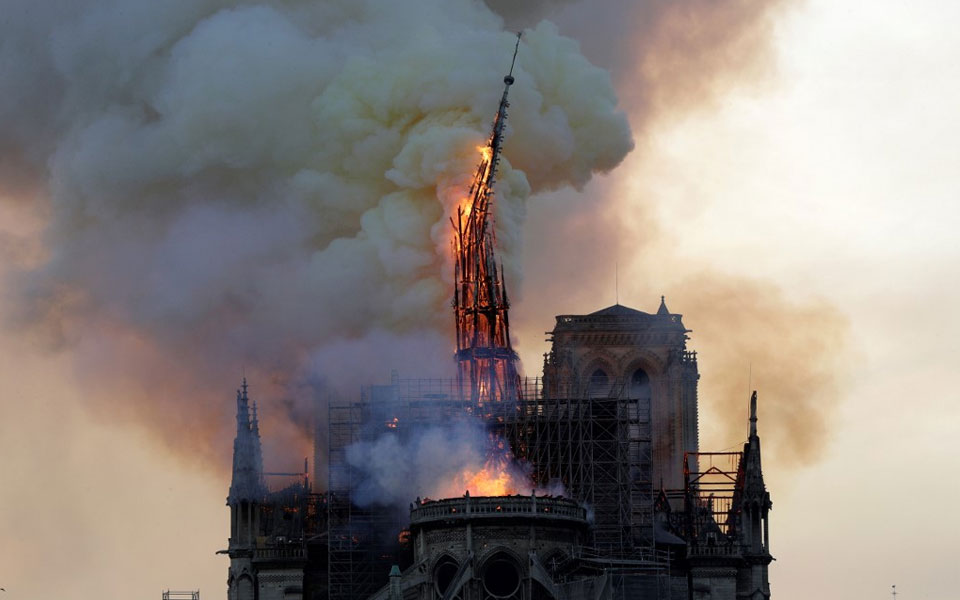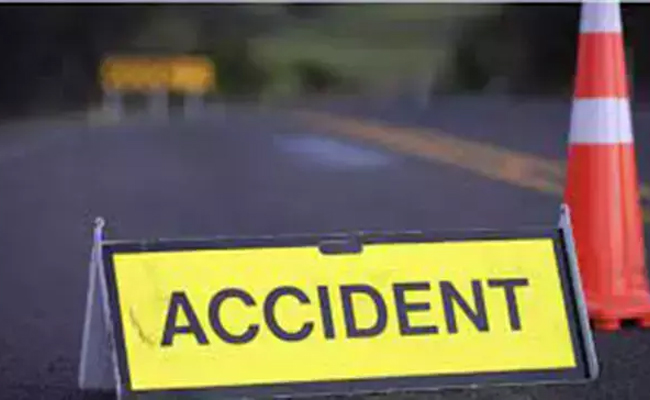Paris: A colossal fire swept through the famed Notre-Dame Cathedral in central Paris on Monday, causing a spire to collapse and threatening to destroy the entire masterpiece and its precious artworks.
The fire, which began in the early evening, sent flames and huge clouds of grey smoke billowing into the Paris sky as stunned Parisians and tourists watched on in sheer horror.
Some were in tears, others offered prayers from the banks of the river Seine as the much-loved attraction at the heart of the City of Light was consumed by the inferno.
"This is really sad - the saddest thing I've ever stood and watched in my life," said British tourist Sam Ogden, a 50-year-old onlooker, who had come to visit the cathedral with her family.
Gasps and cries of "Oh my god" erupted around an hour after the fire first broke out when the top portion of the church's spire came crashing down.
"It looked tiny to begin with, then within an hour it all came down," Ogden added.
The cause of the blaze was not immediately confirmed but the cathedral had been undergoing intense restoration work wich the fire service said could be to blame.
Last week, dramatic footage had shown workers removing 16 copper statues from the spire which was undergoing a revamp financed by the state and private donors.
Deputy Paris mayor Emmanuel Gregoire told BFM TV the spire "collapsed inwards" and that workers were scrambling "to save all the artworks that can be saved." A spokesman for the cathedral told AFP that the wooden structure supporting the roof was being gutted by the blaze.
"Everything is burning," the spokesman for Notre Dame, Andre Finot, told AFP.
President Emmanuel Macron cancelled a major televised policy speech he was due to give on Monday evening over the "terrible fire ravaging Notre-Dame." He headed to the scene in person.
In a tweet he expressed the "emotion of a whole nation" on seeing Notre-Dame ablaze.
"Like all my compatriots I am sad to see a part of us burn this evening" he said, expressing solidarity with "all Catholics and all French people." German Chancellor Angela Merkel called Notre-Dame cathedral a "symbol of European culture" as the blaze raged.
There was no immediate indication of any casualties in the blaze.
"The Paris fire service is trying to control the flames," Paris's Mayor Anne Hidalgo wrote on Twitter, asking residents to respect the security cordon thrown up around the site.
A spokesperson for the cathedral said the fire, which comes as French Catholics prepare to celebrate Easter, broke out at around 1650 GMT.
US President Donald Trump in a tweet said: "So horrible to watch the massive fire at Notre Dame Cathedral in Paris. Perhaps flying water tankers could be used to put it out. Must act quickly!" Hundreds of people gathered on the bridges of Paris downriver to witness the scene, many filming the images with their smartphones.
The cathedral was located at the centre of the French capital in the Middle Ages and its construction was completed in the mid-12th century after some 200 years of work.
During the French Revolution in the 18th century, the cathedral was vandalised duing widespread anti-Catholic violence: its spire was dismantled, its treasures plundered and its large statues at the grand entrance doors destroyed.
It would go on to feature as a central character in a Victor Hugo novel published in 1831, "The Hunchback of Notre Dame" and shortly afterwards a restoration project lasting two decades got underway, led by architect Eugene Viollet-le-Duc.
It would survive the devastation of two world conflicts in the 20th century and famously rang its bells on August 24, 1944, the day of the Liberation of Paris from German occupation at the end of the WWII.
"Paris is disfigured. The city will never be like it was before," said Philippe, a communications worker in his mid-30s, who had biked over to the scene after being alerted of the fire by a friend.
"It's a tragedy," he added. "If you pray, now is the time to pray."
Let the Truth be known. If you read VB and like VB, please be a VB Supporter and Help us deliver the Truth to one and all.
Chennai (PTI): Streaming service JioHotstar on Tuesday announced that it will invest Rs 4,000 crore over the next five years to strengthen South India’s creative economy, unveiling a 25-title slate as part of a major push for regional content.
In one of the biggest announcements by an Indian streaming platform for the southern markets, the company showcased its “South Unbound” vision at a high-profile event here.
Sushant Sreeram, Head – SVOD Business & Chief Marketing Officer at JioStar, said the investment forms part of a broader collaboration with the Tamil Nadu government.
“Earlier today, JioHotstar formalised a Letter of Intent with the Government of Tamil Nadu in the presence of the Chief Minister M K Stalin. This outlines a shared commitment to invest in talent, expand infrastructure and build a future-ready creative economy from the South.
"As part of this vision, JioHotstar will invest Rs 4,000 crore to nurture creators, strengthen the production ecosystem and build a pipeline of stories that are ready for India and ready for the world,” he said.
Calling South India the “heartbeat of Indian storytelling”, Sreeram said the investment signalled the platform’s long-term commitment to local creators.
"JioHotstar started as a dream — to build entertainment rooted in India’s storytelling heritage and powered by cutting-edge technology. The resplendent storytelling traditions of the South motivate us to keep championing authentic, rooted narratives while offering greater accessibility and choices for every viewer," he said.
The event was attended by Tamil Nadu Deputy Chief Minister Udhayanidhi Stalin, veteran actor and MP Kamal Haasan, senior state officials, and leading stars and filmmakers from across the southern industries.
Deputy CM Stalin said the partnership will generate “1,000 direct jobs and 15,000 indirect jobs”.
“Cinema in Tamil Nadu has always been a force for social change. OTT is not replacing cinema; it is expanding it. Today, a filmmaker in Madurai or Salem can upload a story and reach audiences across the world. The cultural and economic impact of this partnership will be massive," he added.
aasan said Indian media and entertainment was undergoing a fundamental transformation driven not by technology alone, but by the audience itself.
“We gather at a moment when India’s media and entertainment is not merely growing, it is transforming. For the first time, this shift is not driven by device or format, but by the audience itself,” he said, adding that storytelling today is “screen agnostic”.
“Regional is becoming the new national, and ethnic the new international. Stories born in Madurai, Malappuram or Machilipatnam are no longer regional cinema; they are national cultural events,” Haasan said, giving the example of movies such as “Kantara”, “Drishyam”, “Baahubali”, “Pushpa” and Tamil hits like “Vikram”.
The event was also attended by Mohanlal, Nagarjuna, Vijay Sethupathi, Priyamani, Aishwarya Rajesh and others -- along with directors Jeethu Joseph and Ahammed Khabeer
The streamer's ambitious content slate, unveiled as part of its “South Unbound” initiative, includes sequels to blockbuster franchises, new long-format shows, films, adaptations, and high-engagement reality formats.
The Tamil slate features a mix of returning favourites and new originals, led by "Bigg Boss Tamil", now hosted by Vijay Sethupathi, and "Good Wife S2", the legal drama starring Priyamani.
The lineup also includes "LBW – Love Beyond Wicket", a relationship drama; the family comedy "Cousins and Kalyanams"; the psychological drama "Resort"; and "Heartbeat S3", which brings back Anumol, Karthik Kumar and Deepa Balu.
Other Tamil offerings include "Lingam", an action-drama; "Love Always", a multigenerational love story; the marquee title "Kaattaan" starring Vijay Sethupathi and Milind Soman; and "Second Love", a non-fiction relationship series.
In Telugu, the platform returns with "Bigg Boss Telugu" hosted by Nagarjuna, alongside new originals such as "Moodu Lantharlu" starring Aishwarya Rajesh; the police procedural "Vikram on Duty"; "Varam", a mystical relationship drama; and the hit comedy-drama "Save The Tigers S3" with Chaitanya Krishna.
The slate further includes "Vishakha", the Telugu adaptation of "Aarya" led by Kajal Aggarwal; the relationship-based non-fiction format "Mad for Each Other"; and the Telugu debut of the iconic adventure franchise "Roadies".
From Malayalam, the platform brings back "Bigg Boss Malayalam" hosted by Mohanlal; "Kerala Crime Files S3" featuring Aju Varghese; the mystery drama "Secret Stories: Roslin"; "Anali", "1000 Babies S2" with Neena Gupta and Rahman; and the hard-hitting drama "Pharma" starring Nivin Pauly.
The Kannada lineup includes "Bigg Boss Kannada" hosted by Kichcha Sudeepa; "Batchmates", a nostalgic friendship drama; and the food-and-humour-based non-fiction series "Comedy Cooks".
Across languages, the platform also announced new films such as "Lucky The Superstar", featuring GV Prakash, Anaswara Rajan and Meghna Sumesh, and "Kenatha Kaanom", positioned as broad-appeal mainstream entertainers.





